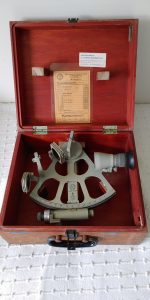A beginner’s journey into Celestial Navigation
Lessons learnt and mistakes made
 Like many people I have been casting around for ideas to keep me stimulated during the 2020 Covid lockdown period. One item that has been on the ‘to do’ list for some time was the Yachtmaster Ocean theory. This is a navigation course which includes the principles and practice of Celestial Navigation. It might seem strange that a professional sailor has not already got this in the ‘tool box’, but the honest truth is that there has never been any need for it up till now. Let’s face it, coastal navigation doesn’t require the sun or stars for a fix, and further offshore we would generally fall back on GPS (GNSS to be precise).
Like many people I have been casting around for ideas to keep me stimulated during the 2020 Covid lockdown period. One item that has been on the ‘to do’ list for some time was the Yachtmaster Ocean theory. This is a navigation course which includes the principles and practice of Celestial Navigation. It might seem strange that a professional sailor has not already got this in the ‘tool box’, but the honest truth is that there has never been any need for it up till now. Let’s face it, coastal navigation doesn’t require the sun or stars for a fix, and further offshore we would generally fall back on GPS (GNSS to be precise).
Deep down, I have felt my lack of expertise, particularly because I much admire navigators of earlier generations who got around the high seas using traditional methods. This includes my father who served as a seaman officer in the Royal Navy.
So, I have signed up for the RYA Yachtmaster Ocean theory course, as offered by an online school. Furthermore, I have spent a number of hours trawling through EBay offerings in search of a pukka sextant to call my own. This post – and those that follow – will take you through the lessons learnt from these two projects.
At this point it is important to point out that the RYA theory course clearly states that it is not necessary to have access to a sextant to do the course. All well and good, but that seems rather like preparing for a driving test without having access to a car. So, a decision to purchase a sextant was made.
Sextant
Firstly, I had not appreciated that there would be such a vast range of marine sextants available to buy, both new and second hand. The second hand seem to fall into a few broad categories: collectible antiques, reproductions, and modern used marine instruments.
It has become apparent that many navigators would never consider buying a used sextant for serious navigational use. The reasons for this position have become evident to me having gone ahead and bought one. The alternative is to buy a new sextant which are certainly available. These include ‘beginner’ plastic sextants made by Davis which retail for £150 – £250. Alternatively, professional sextants can be found such as by famous makers Cassens & Plath, Freiberger and Tamaya – you’ll need to fork out over £1000 for one of those.
Being a stubborn sort, I thought I knew best. I reckoned to buy a second hand quality instrument made by one of the names mentioned above. The logic here was clear: to get the real thing without paying full whack.
I love haunting EBay like many people do, and I found two Freiberger sextants up for sale, with similar age, and aimed to get one or other of these. The Freiberger Trommelsextant (Drum sextant) has been made for many years, originally in East Germany, and is evidently considered the ‘real deal’ by many users. Both of the sextants I had my eye on dated from 1972 – one seemed pristine and the other rather neglected. To cut a long story short, the pristine one went to a higher bidder (for £385 I think), so I determined to get the other. This I paid £200 for.
Seems a good deal? Watch this space.

